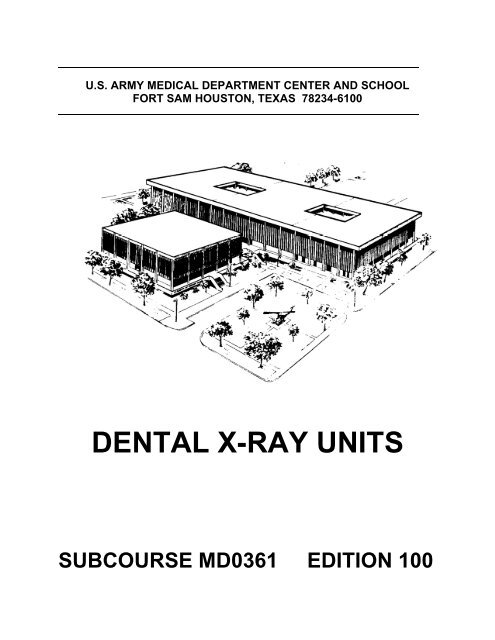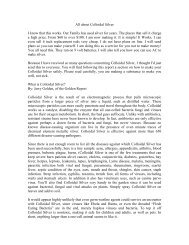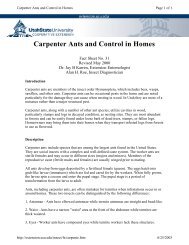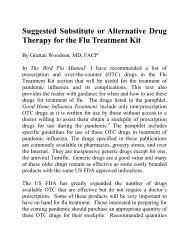Dental X-Ray Units MD0361 - US Army - Survival-training.info
Dental X-Ray Units MD0361 - US Army - Survival-training.info
Dental X-Ray Units MD0361 - US Army - Survival-training.info
You also want an ePaper? Increase the reach of your titles
YUMPU automatically turns print PDFs into web optimized ePapers that Google loves.
U.S. ARMY MEDICAL DEPARTMENT CENTER AND SCHOOL<br />
FORT SAM HO<strong>US</strong>TON, TEXAS 78234-6100<br />
DENTAL X-RAY UNITS<br />
SUBCOURSE <strong>MD0361</strong> EDITION 100
DEVELOPMENT<br />
This subcourse is approved for resident and correspondence course instruction. It<br />
reflects the current thought of the Academy of Health Sciences and conforms to printed<br />
Department of the <strong>Army</strong> doctrine as closely as currently possible. Development and<br />
progress render such doctrine continuously subject to change.<br />
ADMINISTRATION<br />
Students who desire credit hours for this correspondence subcourse must enroll in the<br />
subcourse. Application for enrollment should be made at the Internet website:<br />
http://www.atrrs.army.mil. You can access the course catalog in the upper right corner.<br />
Enter School Code 555 for medical correspondence courses. Copy down the course<br />
number and title. To apply for enrollment, return to the main ATRRS screen and scroll<br />
down the right side for ATRRS Channels. Click on SELF DEVELOPMENT to open the<br />
application; then follow the on-screen instructions.<br />
For comments or questions regarding enrollment, student records, or examination<br />
shipments, contact the Nonresident Instruction Branch at DSN 471-5877, commercial<br />
(210) 221-5877, toll-free 1-800-344-2380; fax: 210-221-4012 or DSN 471-4012, e-mail<br />
accp@amedd.army.mil, or write to:<br />
NONRESIDENT INSTRUCTION BRANCH<br />
AMEDDC&S<br />
ATTN: MCCS-HSN<br />
2105 11TH STREET SUITE 4191<br />
FORT SAM HO<strong>US</strong>TON TX 78234-5064<br />
Be sure your social security number is on all correspondence sent to the Academy of<br />
Health Sciences.<br />
CLARIFICATION OF TERMINOLOGY<br />
When used in this publication, words such as "he," "him," "his," and "men" 'are intended<br />
to include both the masculine and feminine genders, unless specifically stated otherwise<br />
or when obvious in context.<br />
<strong>US</strong>E OF PROPRIETARY NAMES<br />
The initial letters of the names of some products may be capitalized in this subcourse.<br />
Such names are proprietary names, that is, brand names or trademarks. Proprietary<br />
names have been used in this subcourse only to make it a more effective learning aid.<br />
The use of any name, proprietary or otherwise, should not be interpreted as<br />
endorsement, deprecation, or criticism of a product; nor should such use be considered<br />
to interpret the validity of proprietary rights in a name, whether it is registered or not.
TABLE OF CONTENTS<br />
Lesson<br />
Paragraphs<br />
INTRODUCTION<br />
1 PERFORM PREVENTIVE MAINTENANCE CHECKS AND<br />
SERVICES ON THE INTER-ORAL DENTAL X-RAY ................. 1-1--1-4<br />
Exercises<br />
2 PERFORM VERIFICATION/CALIBRATION OF THE<br />
INTER-ORAL DENTAL X-RAY .................................................. 2-1--2-5<br />
Exercises<br />
3 ISOLATE MALFUNCTIONS TO MODULE LEVEL<br />
IN THE INTER-ORAL DENTAL X-RAY ...................................... 3-1--3-7<br />
Exercises<br />
4 REMOVE AND REPLACE OR REPAIR DEFECTIVE<br />
MODULES IN THE INTER-ORAL DENTAL X-RAY ..................... 4-1--4-5<br />
Exercises<br />
<strong>MD0361</strong><br />
i
CORRESPONDENCE COURSE OF<br />
THE U.S. ARMY MEDICAL DEPARTMENT CENTER AND SCHOOL<br />
SUBCOURSE <strong>MD0361</strong><br />
DENTAL X-RAY UNITS<br />
INTRODUCTION<br />
The seven milliampere (ma) Portaray Heliodent is a portable field dental X-ray<br />
apparatus suitable for use in intra-oral radiology. The Portaray can be operated on an<br />
adequate power supply at 50 Hertz cycles per second (Hz) or 60 Hz. When connected<br />
to the transformer built into the case, it can also be operated on heavier power supplies.<br />
It is your job to keep it operationally efficient. The material in this subcourse provides<br />
the preventive maintenance checks and services (PMCS), verification/calibration,<br />
malfunction isolation, and removal and replacement procedures you use to accomplish<br />
this task.<br />
Subcourse Components:<br />
This subcourse consists of 4 lessons as follows:<br />
‣ Lesson 1, Perform Preventive Maintenance Checks and Services on the<br />
Inter-oral <strong>Dental</strong> X-ray.<br />
‣ Lesson 2, Perform Verification/Calibration of the Inter-oral <strong>Dental</strong> X-ray.<br />
‣ Lesson 3, Isolate Malfunctions to Module Level in the Inter-oral <strong>Dental</strong> X-ray.<br />
‣ Lesson 4, Remove and Replace Defective Modules in the Inter-oral <strong>Dental</strong> X-ray.<br />
Credit Awarded:<br />
Upon successful completion of the examination for this subcourse, you will be<br />
awarded 5 credit hours.<br />
To receive credit hours, you must be officially enrolled and complete an<br />
examination furnished by the Nonresident Instruction Branch at Fort Sam Houston,<br />
Texas.<br />
You can enroll by going to the web site http://atrrs.army.mil and enrolling under<br />
"Self Development" (School Code 555).<br />
A listing of correspondence courses and subcourses available through the<br />
Nonresident Instruction Section is found in Chapter 4 of DA Pamphlet 350-59, <strong>Army</strong><br />
Correspondence Course Program Catalog. The DA PAM is available at the following<br />
website: http://www.usapa.army.mil/pdffiles/p350-59.pdf.<br />
<strong>MD0361</strong><br />
ii
LESSON ASSIGNMENT<br />
LESSON 1<br />
Perform Preventive Maintenance Checks and Services<br />
on the Inter-oral <strong>Dental</strong> X-ray.<br />
TEXT ASSIGNMENT Paragraphs 1-1 through 1-4.<br />
LESSON OBJECTIVES<br />
After completing this lesson, you should be able to:<br />
1-1. Identify the components of the Inter-oral <strong>Dental</strong><br />
X-ray.<br />
1-2. Identify the daily, weekly, monthly, quarterly and<br />
annual Preventive Maintenance Checks and Services<br />
(PMCS) procedures for the Inter-oral <strong>Dental</strong> X-ray.<br />
1-3. Identify the equipment required to perform<br />
periodic PMCS on the Inter-oral <strong>Dental</strong> X-ray.<br />
SUGGESTION<br />
After completing the assignment, complete the<br />
exercises at the end of this lesson. These exercises<br />
will help you to achieve the lesson objectives.<br />
<strong>MD0361</strong> 1-1
LESSON 1<br />
PERFORM PREVENTIVE MAINTENANCE CHECKS AND SERVICES<br />
ON THE INTER-ORAL DENTAL X-RAY<br />
1-1. GENERAL<br />
To stay in compliance with the Department of Health and Human Services<br />
(DHHS) requirements, you must maintain the Portaray Heliodent portable field dental<br />
X-ray apparatus annually. It is your responsibility to maintain the equipment with the<br />
manufacturer's recommended maintenance schedule to ensure compliance with the<br />
Federal Performance Standard. Your failure to perform the manufacturer's<br />
recommended maintenance relieves the manufacturer and his agents from<br />
responsibility.<br />
1-2. PORTARAY COMPONENTS AND OPERATING CONCEPT<br />
The Portaray unit consists on a carrying case, support stand, scissors arm, tube<br />
head assembly, a control assembly, and a patient chair with adjustable head rest. The<br />
unit has an operating tube voltage of 70 kilovolt potential (kvp) and a tube current of<br />
7ma. The aluminum (Al) filtration in the useful beam is 2.7mm (millimeters) total. You<br />
accomplish the exposure technique setting by matching the patient to the object on the<br />
dial corresponding to the object being radiographed. You can operate the Portaray on<br />
an adequate power supply of 109 volts alternating current (vac) to 133vac at 60 Hertz<br />
(Hz), 109vac to 132vac at 50 Hz, and when you connect it to the transformer built into<br />
the case, at 207vac to 242vac at 60 Hz and 207vac to 240vac at 50 Hz. See figure 1-1.<br />
<strong>MD0361</strong> 1-2
Figure 1-1. Portaray system and its major components.<br />
<strong>MD0361</strong> 1-3
1-3. FORMS AND EQUIPMENT REQUIRED FOR PREVENTIVE MAINTENANCE<br />
CHECKS AND SERVICES<br />
a. Forms. Each time PMCS is scheduled on a dental X-ray, unit you will receive<br />
DD Form 314 (Preventive Maintenance Schedule and Record), DA Form 2409<br />
(Equipment Maintenance Log), and, if the unit is on an automated system, a report from<br />
either The <strong>Army</strong> Maintenance Management Information System (TAMMIS) or the <strong>Army</strong><br />
Medical Department Property Accounting System (AMEDDPAS).<br />
(1) Check the performance history of the X-ray for any recurrent problem.<br />
Check DA Form 2404 (Equipment Inspection and Maintenance Worksheet), if available,<br />
or the automated print out, as necessary.<br />
(2) Be alert for any systematic problems that you find during your review.<br />
(3) If you are on a manual system (non-automated), record all uncorrected<br />
conditions on DA Form 2404 as you perform PMCS.<br />
forms.<br />
(4) For a manual system, record the performance of PMCS on the following<br />
(a) DD Form 314. Update after completing PMCS.<br />
(b) DD Form 2164 (X-ray Verification/ Certification Worksheet).<br />
Complete and attach a list of test equipment used during procedure.<br />
(c)<br />
DA Form 2409. Update after completing PMCS.<br />
(d) DD Form 2163 (Medical Equipment Verification/Certification Label.<br />
Complete and attach to the unit.<br />
(5) Complete a DA Form 2407 (Maintenance Request) and, if applicable, a<br />
DA Form 2406 (Material Condition Status Report [MCSR]) if additional maintenance is<br />
required.<br />
b. Equipment. To perform PMCS on a field dental X-ray machine you need the<br />
following equipment.<br />
(1) A digital multimeter with the following specifications:<br />
(a) Alternating current (ac) voltage + 0.5% of reading plus 1 digit.<br />
(b) Direct current (dc) voltage + 0.1% of reading plus 2 digits.<br />
(c)<br />
Dc current + 0.3% of reading plus 1 digit.<br />
<strong>MD0361</strong> 1-4
(2) Electromechanical pulse counter MODEL-KESSLER ELLIS KT 203+1<br />
pulse, or equivalent.<br />
(3) Regulating transformer (stepless) 90--150vac, 50 volt amperes (va).<br />
(4) Medical equipment organizational maintenance tool kit.<br />
1-4. PERFORM PMCS ON A FIELD DENTAL X-RAY UNIT<br />
There are four PMCS performed on the field dental X-ray unit; annual, quarterly,<br />
weekly, and daily. Different procedural steps apply to each one.<br />
WARNINGS<br />
You must perform visual checks before connecting the unit to an<br />
adequate power supply.<br />
During the exposure, nobody should be inside the useful X-ray beam.<br />
The operator must be at least 6 feet away from the X-ray head, and not<br />
in the direction of the radiation. Make full use of the length of the hand<br />
switch exposure cable.<br />
a. Annual PMCS. Upon initial setup and annually thereafter, you must service<br />
the X-ray control to keep it in compliance with the DHHS Performance Standard.<br />
(1) Check the exterior of the X-ray using the following procedures.<br />
(a) Verify that all labels are affixed and legible. See figure 1-2.<br />
safety.<br />
(b) Look for mechanical damage that may possibly affect radiation<br />
(c)<br />
Inspect the collimator for cracks.<br />
(d) Test the tube head in all working positions for possible drift.<br />
<strong>MD0361</strong> 1-5
Figure 1-2. Product label placement.<br />
<strong>MD0361</strong> 1-6
(2) Verify that the line compensation light emitting diode (led) [yellow, green,<br />
red]) lights up the digital line adequacy voltmeter.<br />
(3) Check the radiation warning light and the acoustic buzzer for proper<br />
functioning.<br />
(4) Make sure that the deadman feature interrupts the X-ray exposure after<br />
releasing the exposure switch. If the X-ray exposure is not interrupted, perform the<br />
following procedures.<br />
3-4a(1)(a)(e).<br />
2-5a-f.<br />
(a) Test the deadman feature as described in Lesson 3, paragraph<br />
(b) Calibrate the exposure time per procedures in Lesson 2, paragraph<br />
(5) Calibrate the unit. See Lesson 2, Perform Verification/Calibration of the<br />
Inter-oral <strong>Dental</strong> X-ray.<br />
(6) Exchange the desiccant bag 18 months after date of manufacture and<br />
then every year. The desiccant bag is in the storage packaging and has a color<br />
indicator: blue means "good," pink means "not good."<br />
b. Quarterly PREVENTIVE MAINTENANCE CHECKS AND SERVICES.<br />
When you receive DD Form 314, on a dental X-ray unit for scheduled PMCS, you perform<br />
the PMCS. To perform PMCS on a field dental X-ray machine you need the following<br />
equipment; the multimeter and pulse counter designated in paragraph 1-3 above. Use<br />
the following procedures.<br />
(1) Inspect the carrying case to ensure the following conditions exist.<br />
(a) The carrying handles and latches are not broken or missing.<br />
(b) The pressure relief valve is operational, that is, the push button is not<br />
broken or missing and springs back after release.<br />
(c)<br />
The case lid gasket does not have cuts or nicks.<br />
(d) All straps are intact.<br />
(e) The leveling devices are not broken or missing and are functional.<br />
<strong>MD0361</strong> 1-7
(2) Inspect the seat assembly to ensure the following conditions exist.<br />
(a) The adjustable brackets are operational.<br />
(b) The head rest adjusts throughout its range of motion.<br />
(c)<br />
The dowel pins and chains are not broken or missing.<br />
(d) The seat and the back rest are not splintered or broken.<br />
(3) Inspect the scissors arm assembly spring adjustment. Position the tube<br />
head in a 45º angle to the vertical scissors arm. If the scissors arm does not return by<br />
itself to 45º, the friction pad requires adjustment. See figure 1-3. Use the following<br />
procedures to adjust the friction pad.<br />
(a) Loosen the locking screws (A) for the spring-arm adjustment<br />
screws in the pivoting arm by turning them (1 1/2 turns maximum).<br />
(b) Remove the screw caps (B) from the double joint of the scissors<br />
arm. See figure 1-4.<br />
(c) Adjust the spring with screw C if the angle is more than 45º. See<br />
figures 1-4, 1-5, and 1-6.<br />
(d) Adjust the spring with screw D if the angle is less than 45º. See<br />
figures 1-4, 1-5, and 1-6.<br />
figure 1-3.<br />
(e) Tighten screw A by turning it (1 1/2 turns maximum). See<br />
<strong>MD0361</strong> 1-8
Figure 1-3. Rotation adjustment, step 1.<br />
Figure 1-4. Rotation adjustment, step 2.<br />
Figure 1-5. Rotation adjustment, step 3.<br />
Figure 1-6. Rotation adjustment, step 4.<br />
<strong>MD0361</strong> 1-9
(4) If the tube head drifts, the brake is malfunctioning. Adjust the brake with<br />
an open-end wrench. See figure 1-7.<br />
(a) Tighten the brake firmly but gently.<br />
(b) Check the various arm positions for drifting.<br />
Figure 1-7. Open-end wrench 13mm--`1/2 inch.<br />
(5) Inspect the control and the tube for a burned light bulb.<br />
(6) Inspect the hand control cable for cuts and nicks.<br />
WARNING<br />
The power supply must be grounded.<br />
<strong>MD0361</strong> 1-10
(7) Verify the adequacy of the power supply.<br />
NOTE:<br />
Line voltage must be 109 to 133vac at 60 Hz or 109 to 132vac at 50 Hz.<br />
If the line voltage is not within tolerance you must replace the voltage source.<br />
(a) Remove the front cover by removing the two screws on the top and<br />
the two screws on the bottom of the front cover. See figure 1-8.<br />
Figure 1-8. Multimeter connections for power supply adequacy test.<br />
<strong>MD0361</strong> 1-11
(b) Set the multimeter selection to 150vac.<br />
(c) Connect the multimeter leads to terminals K3 N and L.<br />
(d) Turn the unit on and allow it to warm up for five minutes.<br />
(e) Verify that the voltage on the multimeter coincides with the unit's<br />
dvm. The measured line voltage must be at least 109vac, and may not exceed 133vac.<br />
NOTE:<br />
If the voltage values are not within one volt (v), the unit's dvm must be<br />
calibrated before continuing. See Lesson 2, Perform Verification/Calibration<br />
of the Inter-oral <strong>Dental</strong> X-ray.<br />
(f)<br />
green led is on.<br />
Adjust the line compensation switch, if necessary, and verify the<br />
(g) Record the readings with no load.<br />
(h) Set the exposure time to 3.2 seconds and make an exposure.<br />
(i)<br />
Record the readings of the unit's dvm with a load.<br />
(j) As illustrated in the example shown below, determine the voltage<br />
drop under load by subtracting "the voltage under load" from "the no load voltage."<br />
NO LOAD VOLTAGE 125v<br />
minus VOLTAGE UNDER LOAD 120v<br />
VOLTAGE DROP<br />
5v<br />
NOTE:<br />
The maximum permissible voltage drop between the no load voltage and the<br />
voltage under load must not exceed 6 volts during the entire operation. If the<br />
voltage drop exceeds 6 volts, you must replace the power source.<br />
(8) Verify the tube head current.<br />
(a) Turn off the unit.<br />
(b) Remove the 9,10 jumper circuit board D1. See figure 1-9.<br />
(c) Connect the multimeter to D1 9,10. See figure 1-9.<br />
<strong>MD0361</strong> 1-12
Figure 1-9. Tube head current verification.<br />
<strong>MD0361</strong> 1-13
(d) Turn the unit on and allow a 5-minute warm-up period.<br />
(e) Set the multimeter to direct current milliampere (dcma) and range<br />
control to 10ma.<br />
(f) Set the time selector to 2.0 seconds and make an exposure by<br />
holding the exposure button down.<br />
(g) Ensure the buzzer sounds and the red radiation light comes on.<br />
(h) Record the ma reading on the multimeter.<br />
NOTE:<br />
The reading should be 7ma with a tolerance of +1.2ma to -2ma at 60 Hz or<br />
+1.0ma to -2.5ma at 50 Hz. If the tolerance is exceeded, you must replace or<br />
repair circuit board D1.<br />
(i)<br />
Replace the cover on the control.<br />
(9) Inspect the tube head from stop to stop. If the tube head turns more<br />
than 540º (1 1/2 turns), you must replace the rotational part. See Lesson 4, Remove<br />
and Replace or Repair defective modules in the Inter-oral <strong>Dental</strong> X-ray.<br />
(10) Correct minor deficiencies.<br />
(11) Record the deficiencies not corrected on DA Form 2404 and complete<br />
the appropriate reports and forms.<br />
c. Weekly Preventive Maintenance Checks and Services. Within one week<br />
of previous weekly maintenance or if equipment is dusty or dirty, wipe all equipment<br />
surfaces with a damp lint free cloth.<br />
d. Daily Preventive Maintenance Checks and Services. You must conduct<br />
visual checks and tests before the unit is operated.<br />
(1) Verify that all labels are affixed and legible. See figure 1-2.<br />
(2) Look for mechanical damage possibly affecting radiation safety.<br />
(3) Inspect components for rust, cracks, wear, fraying electrical cords,<br />
missing parts, and operator's publication.<br />
(4) Test the tube head in all working positions for possible drift.<br />
<strong>MD0361</strong> 1-14
(5) Look at the operating-ready light (green led), line compensation<br />
indicators leds, and the digital line adequacy voltmeter. The operating-ready light must<br />
light up and the must be functional.<br />
(6) Correct any minor deficiencies noted in PMCS.<br />
(7) Record any deficiencies that are not corrected on a DA Form 2404.<br />
e. Mechanical Damage. Should mechanical damage affecting radiation be<br />
evident, the apparatus may not be used until you correct the defect.<br />
Continue with Exercises<br />
<strong>MD0361</strong> 1-15
EXERCISES, LESSON 1<br />
INSTRUCTIONS: Answer the following items by completing the statement or by writing<br />
the answer in the space provided at the end of the item.<br />
After you have completed all of these items, turn to "Solutions to Exercises" at the<br />
end of the lesson and check your answers with the solutions.<br />
SITUATION: Use Exercise Figure 1 for items 1-3. Select from answers 1-8.<br />
Exercise Figure 1.<br />
1. Which number is the scissors arm ____________<br />
2. Which number is the X-ray head ____________<br />
3. Which number is the transformer ___________<br />
<strong>MD0361</strong> 1-16
4. At a minimum, how often must you service the X-ray control to keep it in<br />
compliance with the DHHS Performance Standard<br />
a. Annually.<br />
b. Quarterly.<br />
c. Weekly.<br />
d. Daily.<br />
5. At least how far away from the X-ray head must you be when making an<br />
exposure<br />
a. 3 feet.<br />
b. 5 feet.<br />
c. 6 feet.<br />
d. 10 feet.<br />
6. On an annual basis you must change the desiccant bag. Which of the following<br />
colors means "not good"<br />
a. Red.<br />
b. Blue.<br />
c. Pink.<br />
d. White.<br />
7. During a quarterly PMCS you inspect the carrying case to ensure which of the<br />
following conditions<br />
a. The adjustable brackets are operational.<br />
b. The dowel pins and chains are not broken.<br />
c. The leveling devices are functional.<br />
d. The power supply is adequate.<br />
<strong>MD0361</strong> 1-17
8. Based upon the illustration below, what is the letter of the screw used to adjust the<br />
scissors arm if the angle is less than 45 degrees<br />
a. A.<br />
b. B.<br />
c. C.<br />
d. D.<br />
<strong>MD0361</strong> 1-18
9. What is the maximum permissible voltage drop between the no load voltage and<br />
the voltage under load<br />
a. 3 volts.<br />
b. 5 volts.<br />
c. 6 volts.<br />
d. 10 volts.<br />
10. Which of the following procedures must you do at least weekly<br />
a. Wipe the equipment surfaces with a damp lint free cloth.<br />
b. Inspect the control and tube for burned light bulb.<br />
c. Verify the tube head current.<br />
d. Inspect the seat assembly.<br />
11. Before the machine is used, which of these procedures must you perform as part<br />
of the daily PMCS<br />
a. Wipe the equipment surfaces with a damp lint free cloth.<br />
b. Inspect components for rust, cracks, and wear.<br />
c. Adjust the scissors assembly spring to 45 degrees, as necessary.<br />
d. Determine the voltage drop under load.<br />
Check Your Answers on Next Page<br />
<strong>MD0361</strong> 1-19
SOLUTIONS TO EXERCISES, LESSON 1.<br />
1. a (figure 1-1)<br />
2. b (figure 1-1)<br />
3. c (figure 1-1)<br />
4. a (para 1-4a)<br />
5. c (para 1-4a WARNING)<br />
6. c (para 1-4a(6))<br />
7. c (para 1-4b(1)(e))<br />
8. b (para 1-4b(3)(d))<br />
9. c (para 1-4b(7)(j) NOTE)<br />
10. a (para 1-4c)<br />
11. b (para 1-4d(3))<br />
End of Lesson 1<br />
<strong>MD0361</strong> 1-20
LESSON ASSIGNMENT<br />
LESSON 2<br />
Perform Verification/Calibration of the Inter-oral <strong>Dental</strong><br />
X-ray.<br />
TEXT ASSIGNMENT Paragraphs 2-1 through 2-5.<br />
LESSON OBJECTIVES<br />
After completing this lesson, you should be able to:<br />
2-1. Identify the procedures used to calibrate/verify<br />
the Inter-oral <strong>Dental</strong> X-ray, to include verifying<br />
the adequacy of the power supply, calibrating<br />
the digital voltmeter, and verifying/calibrating the<br />
exposure time.<br />
2-2. Identify the calibration parameters for the<br />
Inter-oral <strong>Dental</strong> X-ray.<br />
SUGGESTION<br />
After completing the assignment, complete the<br />
exercises at the end of this lesson. These exercises<br />
will help you to achieve the lesson objectives.<br />
<strong>MD0361</strong> 2-1
2-1. GENERAL<br />
LESSON 2<br />
PERFORM VERIFICATION/CALIBRATION OF THE<br />
INTER-ORAL DENTAL X-RAY<br />
To ensure that the Heliodent 70 portable dental x-ray unit remains safe to<br />
operate and functions properly, the x-ray requires verification/calibration. You must<br />
perform this task at least annually. Refer to paragraph 1-2 for a list of equipment you<br />
need to calibrate the x-ray unit. This lesson covers the following three<br />
verification/calibration tasks: verifying adequacy of the power supply, calibrating the<br />
dvm, and verifying/ calibrating exposure time.<br />
2-2. VERIFICATION/CALIBRATION PARAMETERS<br />
When performing verification/calibration refer to figures 2-1, 2-2, 2-3, 2-4, and<br />
2-5 for device acceptable performance parameters. Measurement base of technique<br />
factors are as follows below.<br />
a. Kilovolt (kv) measurements were obtained using an oscilloscope with<br />
frequency compensated bleeder resistors and a spectrum analyzer.<br />
b. Tube current was measured by a dcma meter, accuracy 1.5 percent accuracy<br />
at full scale.<br />
c. The exposure time was measured with an oscilloscope, and determined using<br />
the time of high-voltage without the pre-heat time.<br />
d. The cooling curve for the tube housing is steeper than is the curve for the<br />
anode because it is measured in 10 4 , not 10 3 heat units (HU). Since the curve is<br />
steeper, even though the anode cools in a shorter period of time, the absolute rate of<br />
cooling for the tube housing is greater.<br />
e. When making x-rays, do not exceed the maximum cumulative HU. For<br />
example, if you make a series of exposures totaling 5000 HU and are required to repeat<br />
the series, you must wait a minimum of 2 minutes before repeating the series. In 2<br />
minutes the unit will retain slightly less than 2000 HUs; repeating a series generating<br />
5000 HUs will raise the cumulative HUs to slightly less than 7000 (2000 remaining HU<br />
from the original exposures + 5000 new HUs from the repeat exposures).<br />
<strong>MD0361</strong> 2-2
Rate maximum peak tube potential 70kv, 70kv/0, 12dcma<br />
leakage technique factors (0.12ma is the<br />
equivalent maximum rated continuous<br />
tube current for 7ma with a duty cycle<br />
1:60)<br />
Minimum filtration in useful beam<br />
2.7mm Al at 70kv<br />
Cooling curve for the tube housing Figure 2-3.<br />
Anode cooling characteristic Figure 2-4.<br />
The tube is designed for self-rectifying mode of operation with the Heliodent only<br />
Nominal tube current (fixed)<br />
7dcma<br />
Nominal peak tube potential (fixed) 70kv<br />
Duty cycle<br />
1 : 60 in seconds<br />
Figure 2-1. Calibration parameters.<br />
60 Hz 50 Hz<br />
Rated nominal line voltage.<br />
125v<br />
230v<br />
125v<br />
230v<br />
Permissible maximum line-voltage regulation at terminal 6v<br />
6v<br />
strip K3.<br />
Line voltage range. 109-133v<br />
207-242v<br />
108-132v<br />
207-240v<br />
Maximum line current at nominal values of 70kv and 125v : 9.5a 17.0a<br />
7dcma.<br />
230v : 5.0a 9.0a<br />
Generator duty cycle at the nominal values of<br />
1:60 in sec. 1:50 in sec.<br />
70kv/7dcma.<br />
Maximum deviation from indicated valves:<br />
a. tube current nominal 7dcma.<br />
b. exposure time. See Figure 2-5.<br />
+ 1.2dcma<br />
- 2.0<br />
+ 1.0dcma<br />
- 2.5dcma<br />
Figure 2-2. Calibration voltage parameters.<br />
<strong>MD0361</strong> 2-3
Figure 2-3. Cooling curve for the tube housing.<br />
Figure 2-4. Anode cooling characteristic.<br />
<strong>MD0361</strong> 2-4
NOMINAL Exposure time: (DENTOTIME)<br />
Exposure time setting (in seconds) Equivalent<br />
pulses<br />
60 HZ 50HZ<br />
MAXIMUM DEVIATION<br />
Accuracy of time setting (in<br />
pulses)<br />
0.066 4 3 +1 -2<br />
0.083 5 4 +1 -2<br />
0.10 6 5 +1 -2<br />
0.13 8 6 +1 -2<br />
0.16 10 8 +1 -2<br />
0.20 12 10 +1 -2<br />
0.25 15 12 +1 -2<br />
0.32 19 16 +1 -2<br />
0.40 24 20 +1 -2<br />
0.50 30 25 +1 -2<br />
0.64 38 32 +2 -4<br />
0.80 48 40 +2 -4<br />
1.0 60 50 +3 -6<br />
1.2 72 60 +3 -6<br />
1.6 96 80 +5 -10<br />
2.0 120 100 +6 -12<br />
2.5 150 125 +7 -14<br />
3.2 192 160 +10 -20<br />
Figure 2-5. Exposure time performance parameters.<br />
2-3. VERIFYING ADEQUACY OF THE POWER SUPPLY<br />
Since the portable x-ray unit requires assembly and disassembly as it is<br />
transported from location to location, you must perform a power supply line adequacy<br />
test every time you reassemble the unit for use. You must document the performance<br />
of the power supply line adequacy test on the Test Record in accordance with local<br />
standard operating procedures. You perform this task as part of scheduled quarterly<br />
PMCS. The specific procedures are described in Lesson 1, Perform PMCS on the<br />
Inter-oral <strong>Dental</strong> X-ray.<br />
2-4. CALIBRATE THE DIGITAL VOLTMETER<br />
To calibrate the digital voltmeter, use the following procedures.<br />
a. Turn the unit off.<br />
b. Remove the screws from the housing cover and remove the cover.<br />
c. Set the multimeter to 150vac.<br />
<strong>MD0361</strong> 2-5
d. Connect the multimeter test leads to terminals K3 N and L on printed circuit<br />
board (pcb) D3 (See figure 2-6).<br />
Figure 2-6. Digital voltage meter calibration.<br />
<strong>MD0361</strong> 2-6
e. Turn the unit on and allow a 5-minute warm-up period.<br />
f. Compare the indicated value of the unit's dvm and the external multimeter.<br />
g. Adjust R7, on pcb D3, until the unit's dvm reading is the same as the<br />
multimeter connected across K3 N and L (See figures 2-5 and 2-6).<br />
(1) To increase the voltage reading on the unit's dvm, turn R7<br />
counterclockwise until it matches the reading with the multimeter connected across K3<br />
N and L.<br />
(2) To decrease the voltage reading on the unit's dvm, turn R7 clockwise<br />
until it matches the reading with the multimeter connected across K3 N and L.<br />
NOTE: The incoming line voltage must be between 109 and 133vac at 60 Hz or 109<br />
and 132vac at 50 Hz for the unit to function properly.<br />
2-5. VERIFY/CALIBRATE EXPOSURE TIME<br />
To perform the exposure time verification with a mechanical counter, use the<br />
following procedures.<br />
a. Turn the unit off.<br />
b. Connect the counter to test points D1.4 and D1.21 on circuit board D1. See<br />
figures 2-7 and 2-8.<br />
<strong>MD0361</strong> 2-7
Figure 2-7. Pcb D3.<br />
<strong>MD0361</strong> 2-8
Figure 2-8. Mechanical counter test points.<br />
c. Turn the unit on and allow a 5-minute warm-up period.<br />
d. Set the exposure time as shown in figure 2-9 and make an exposure. Note<br />
the pulses on the counter.<br />
PULSES<br />
Exposure 50 HZ 60 HZ Tolerance<br />
0.066 sec. 3 4 + 1 pulses<br />
3.2 sec. 160 192 + 10 pulses<br />
- 20 pulses<br />
Figure 2-9. Exposure time tolerances.<br />
<strong>MD0361</strong> 2-9
e. Record the pulses on the monitor.<br />
f. If not within tolerance, adjust the pulse count before proceeding. To adjust<br />
the pulse count, use the following procedures.<br />
(1) Make an exposure.<br />
(2) Adjust the pulse using potentiometer R13 on circuit board D1 until the<br />
proper pulse count is obtained. Refer to figure 2-10.<br />
(a) + = Increase the exposure time.<br />
(b) - = Decrease the exposure time.<br />
Figure 2-10. Pulse count adjustment.<br />
CAUTION:<br />
Observe the cooling time between exposures. See the cooling chart in<br />
the manufacturer's service manual to determine the correct cooling<br />
period for a relative power duration.<br />
Continue with Exercises<br />
<strong>MD0361</strong> 2-10
EXERCISES, LESSON 2<br />
INSTRUCTIONS: Answer the following items by completing the statement or by writing<br />
the answer in the space provided at the end of the item.<br />
After you have completed all of these items, turn to "Solutions to Exercises" at the<br />
end of the lesson and check your answers with the solutions.<br />
1. How often must you calibrate/verify the portable dental x-ray unit<br />
a. Daily.<br />
b. Weekly.<br />
c. Monthly.<br />
d. Annually.<br />
2. How often must you perform a power supply line adequacy test on the portable<br />
dental x-ray unit<br />
a. Before every use.<br />
b. Whenever reassembled.<br />
c. Whenever cleaned.<br />
d. Whenever the unit has lost power.<br />
3. When you calibrate the dvm, you set the multimeter to which of the following vac<br />
a. 50vac.<br />
b. 100vac.<br />
c. 150vac.<br />
d. 250vac.<br />
<strong>MD0361</strong> 2-11
4. When you are calibrating the dvm and the voltage reading does not match the<br />
reading on the multimeter, which of the following procedures do you use<br />
a. If the external multimeter readings are higher than the unit's dvm reading, you<br />
should turn R7 counterclockwise.<br />
b. If the external multimeter readings are lower than the unit's dvm reading, you<br />
should turn R7 counterclockwise.<br />
c. If the external multimeter readings do not match exactly, replace the dvm.<br />
d. If the external multimeter readings do not match, you must replace your power<br />
source.<br />
5. You are verifying the exposure time. Which of the following findings are<br />
acceptable<br />
a. For 0.066 seconds at 50 Hz, you have 5 pulses.<br />
b. For 0.066 seconds at 60 Hz, you have 1 pulse.<br />
c. For 3.2 seconds at 50 Hz, you have 165 pulses.<br />
d. For 3.2 seconds at 60 Hz, you have 171 pulses.<br />
Check Your Answers on Next Page<br />
<strong>MD0361</strong> 2-12
SOLUTIONS TO EXERCISES, LESSON 2<br />
1. d (para 2-1)<br />
2. b (para 2-3)<br />
3. c (para 2-4c)<br />
4. a (para 2-4g(1))<br />
5. c (figure 2-9)<br />
End of Lesson 2<br />
<strong>MD0361</strong> 2-13
LESSON ASSIGNMENT<br />
LESSON 3<br />
Isolate Malfunctions to Module Level in the Inter-oral<br />
<strong>Dental</strong> X-ray.<br />
TEXT ASSIGNMENT Paragraphs 3-1 through 3-7.<br />
LESSON OBJECTIVES<br />
After completing this lesson, you should be able to:<br />
3-1. Identify the steps required to isolate<br />
malfunctions in the Inter-oral <strong>Dental</strong> X-ray to the<br />
module level.<br />
3-2. Identify the functioning of the Heliodent 70<br />
Inter-oral <strong>Dental</strong> X-ray.<br />
SUGGESTION<br />
After completing the assignment, complete the<br />
exercises at the end of this lesson. These exercises<br />
will help you to achieve the lesson objectives.<br />
<strong>MD0361</strong> 3-1
3-1. GENERAL<br />
LESSON 3<br />
ISOLATE MALFUNCTIONS TO MODULE LEVEL IN THE<br />
INTER-ORAL DENTAL X-RAY<br />
This lesson covers the general procedures you will use to isolate malfunctions in<br />
the X-ray, inter-oral, dental to the module level. This lesson also explains the X-ray's<br />
theory of operation and some of the safety hazards resulting from defective X-ray<br />
modules that preclude operation of the unit until you have made repairs.<br />
3-2. HELIODENT 70 MODULES<br />
This lesson further describes the modules discussed in Lesson 1.<br />
a. Power Equipment. Power equipment consists of circuit boards found in the<br />
X-ray control, the transformer, and the protective device. The protective device consists<br />
of a variety of slow and medium slow blow fuses. Refer to figures 3-1, 3-2, and 3-3 for<br />
the location of these devices.<br />
Figure 3-1. X-ray control, external view.<br />
<strong>MD0361</strong> 3-2
Figure 3-2. X-ray control, internal view.<br />
Figure 3-3. Transformer outlet (115v).<br />
<strong>MD0361</strong> 3-3
. X-ray Head. See figure 3-4 for the features of the X-ray head.<br />
Figure 3-4. X-ray head.<br />
<strong>MD0361</strong> 3-4
c. Scissors Arm. Refer to figure 3-5 for the features and layout of the scissors<br />
arm. The scissors arm is spring-loaded to support the X-ray head in a drift-free<br />
condition over an operating range as shown. A five conductor wiring harness connects<br />
the X-ray head to the X-ray control via the scissors arm.<br />
Figure 3-5. Scissors arm.<br />
<strong>MD0361</strong> 3-5
CAUTION:<br />
Removal of the X-ray head requires securing the scissors arm in a semiopened<br />
position to prevent accidental opening (spring-loaded). Refer to<br />
figure 3-6.<br />
3-3. HELIODENT 70 FUNCTIONING<br />
Figure 3-6. Scissors arm strap.<br />
a. Description of Function. Refer to figure 3-7, the logic block diagram<br />
describing the functioning of the Heliodent 70.<br />
(1) The Heliodent 70 X-ray tube is indirectly heated, i.e., the heater and the<br />
high voltage are switched on at the same time. Thus, tube current flows only once the<br />
emission temperature of the filament is reached (after 150 to 250 msec [millisecond]).<br />
As soon as the peak tube current exceeds a given value, the Schmitt trigger (V6)<br />
switches over, the AR relay energizes, and the timer circuit, consisting of C3/R10, V12,<br />
V14 is triggered. The AR relay shorts the resistor R18 and separates the resistor R20<br />
from the power source. Accordingly, the Heliodent is then operated from the line<br />
without damping.<br />
(2) As soon as the capacitor C3 is charged to the threshold voltage set on<br />
the Schmitt trigger, the timer circuit shuts the ER relays down, and the exposure is<br />
terminated. The AR relay drops only as the trigger switch is released.<br />
<strong>MD0361</strong> 3-6
Figure 3-7. Theory of principles of operation--logic block diagram.<br />
<strong>MD0361</strong> 3-7
(3) You cannot measure the tube current between the points X and Y since<br />
an alternating current flows there (tube current plus capacitor-charging current). Thus,<br />
the diodes V2 and V3 have short circuited the capacitor charging current in the tube<br />
current measuring circuit. You may measure the tube current between points<br />
D1.9/D1.10. Refer to figure 3-8.<br />
Figure 3-8. Heliodent 70 secondary circuit.<br />
b. Heliodent 70. The secondary circuit of the Heliodent 70 consists of a<br />
voltage-doubling circuit (C1, V10, H1). The negative half wave of the transformer<br />
voltage charges the capacitor C1. The positive half wave of the transformer voltage is<br />
added to the capacitor voltage, so that twice the transformer peak voltage is required on<br />
the tube. Refer to figure 3-9.<br />
Figure 3-9. Transformer peak voltage doubling.<br />
<strong>MD0361</strong> 3-8
c. Line Input. Fuses U2 and U3 protect the line input. If the switch S1 is on,<br />
the readiness indicating B1 lamp lights. Refer to figure 3-10.<br />
d. Control Transformer. The control transformer ensures that the Heliodent 70<br />
is always operated with a primary voltage of 125v in the line voltage range of 109v to<br />
133v at 60 Hz, 109v to 132v at 50 Hz. The supply of the control transformer is changed<br />
to such an extent with the switch S6 as a function of the input voltage that a voltage of<br />
125v is measured between the terminals T3.1-7. Refer to figure 3-10.<br />
e. Start of Exposure. Refer to figure 3-10.<br />
(1) When you depress the exposure button S27 the relays ER1 and ER2<br />
are controlled via V21 synchronized to the power supply. The Schmitt trigger (V12,<br />
V14) switches and the ER relay energizes.<br />
(2) The relay contacts place the primary winding of the high-voltage<br />
transformer H1 under voltage through the voltage divider R18/R20. At the same time<br />
the buzzer SU and the radiation indicator B2 are caused to operate. They indicate the<br />
duration of the X-ray radiation acoustically and optically.<br />
f. Exposure (Current Path). Refer to figure 3-10.<br />
(1) The base of transistor V19 is supplied with power supply synchronized<br />
positive half waves and a square wave collector output. This output is differentiated by<br />
C8 and R30. The positive peak controls the transistor V20, diode V23. The inverted<br />
peaks are collected at base V21, when exposure button S27 is depressed V21 turns the<br />
timer on. The voltage via dividers R31, R32 controls V20 and V21 as long as S27 is<br />
depressed.<br />
(2) Since the capacitor C3 is not yet charged, the transistor V12 is blocked.<br />
V14 obtains base current through the resistor R12/R14, and is then switched through.<br />
As a result, the relays ER1 and ER2 energize.<br />
(3) The emitter current of V14 flows through the potentiometer R13 and<br />
causes a voltage drop in it. It is thus possible to adjust the threshold voltage of the<br />
Schmitt trigger consisting of V12/V14, the transistor V12 can be controlled through only<br />
once its base voltage exceeds the value of 0.7v + on 13.<br />
<strong>MD0361</strong> 3-9
Figure 3-10. Schematic Heliodent 70 with dentotime.<br />
<strong>MD0361</strong> 3-10
g. Switching Relay AR. Refer to figure 3-10.<br />
(1) As soon as the tube current allows a voltage drop on the resistor R3<br />
which is greater than the following.<br />
U (V4) = 2.4v + U (V5) = 0.7v + U (V6) = 0.7v, the transistor V6 is controlled through.<br />
Then, the transistor V7 is also controlled through R9. The collector current of V7 allows<br />
the AR relay to draw. This relay places the Heliodent 70 transformer under a voltage of<br />
125 without damping.<br />
(2) The collector current of V7 flows, at the same time through V8, R8, R5 to<br />
the base of V6, and keeps V6 in the over-modulated state (flip-flop function). The<br />
capacitor C7 and C2 serve for interference suppression.<br />
(3) The transistor V7 also controls the transistor V17. This transistor serves<br />
as an impedance converter and provides a supply voltage stabilized by V18 to the<br />
integrator, consisting of R10 and C3. The exposure times of 0.066 and 3.2 seconds<br />
(sec) are set in 18 steps with R10.<br />
h. End of Exposure. As soon as C3 is charged to the threshold voltage, which<br />
is adjusted with R13, the transistor V12 switches through. This initiates a flip-flop<br />
process. On the one hand, the transistor V12 short circuits the base section of V14, so<br />
that the current through ER is reduced. On the other hand, the voltage drop on R13<br />
decreases so that the transistor V12 is controlled through even faster. Thus, the ER<br />
relays drop. Refer to figure 3-10.<br />
i. Temperature Compensation. The R11 hot wire compensates the<br />
temperature response of the entire circuit in the 10º to 70º Celsius (C) range. Refer to<br />
figure 3-10.<br />
j. Forced Exposure. Refer to figure 3-10.<br />
(1) In case of a defect where no tube current signal triggers the Dentotime,<br />
there is a forced switching system. The capacitor C7 is charged through the resistor<br />
R16 after switching on.<br />
(2) If no tube current pulse triggers the Dentotime, the transistor V6 is<br />
controlled through over R16 after approximately 0.7 to 1 sec and the timer circuit is<br />
actuated.<br />
<strong>MD0361</strong> 3-11
k. Digital Voltmeter "P" Printed Circuit Board D3. Refer to figures 2-6 and<br />
3-11 for printed circuit board D3.<br />
(1) The digital voltmeter "P" receives a rectified filtered 12.5v measuring<br />
voltage, proportional to a 125v line voltage input. The power supply to the instrument<br />
consists of the transformer T1 (D3) and a 5 volts direct current (vdc) circuit.<br />
(2) The transformer T1 (D5) supplies a line voltage proportional voltage.<br />
This stabilized voltage is supplied to the Schmitt trigger. The Schmitt trigger controls<br />
the respective leds red (RT), green (GN), and yellow (GE) via gates J3 and J4. If there<br />
is an over voltage condition, the Schmitt trigger J5 output drives transistor V9 and relay<br />
AR 1 energizes interrupting the exposure circuit.<br />
Figure 3-11. Pcb D3.<br />
<strong>MD0361</strong> 3-12
l. Line Voltage Indication and Over Voltage Exposure Interruption Printed<br />
Circuit Board D5. Refer to figures 3-12 and 3-13.<br />
(1) The 15v stabilizer receives its input voltage from the power supply of the<br />
timing switch board D1. The transformer T1 (D5) supplies, via rectifier V1, the voltage<br />
for the Schmitt triggers J1 and J5.<br />
(2) The zener diodes V3 and V4 increase the value of the R-C circuit R8, C3<br />
and R5, C4 smoothes the signal input to the Schmitt, trigger J1.2, J1.6, J5.2.<br />
(3) At a lower control voltage the Schmitt trigger J1.1 and J1.7 (signals) are<br />
at H. via the inverter J3 and the AND gate J4, inverter J3.10 signals L, the light diode V6<br />
(yellow) lights up.<br />
(4) As the control voltage increases the output signal of Schmitt trigger J1.7<br />
changes to L, controlled by R11. The output signal of the inverter J3.10 signals L, the<br />
light diode V6 (yellow) lights up.<br />
(5) As the control voltage increases the output signal of Schmitt trigger J1.7<br />
changes to L, controlled by R11. The output signal of the inverter J3.10 changes from L<br />
to H.<br />
(6) The light diode V6 is de-energized J3.12 in turn switches to output from<br />
H to L and the light diode V7 (green) lights up (nominal unit operating condition).<br />
(7) As the control voltage increases further (over voltage condition) the<br />
output signal of J1.1 controlled via R10, switches from H to L.<br />
(8) The output of J3.12 changes from L to H and 3.15 changes from H to L.<br />
The light diode V7 (green) is de-energized and light diode V5 (red) lights up.<br />
(9) At a control voltage, corresponding to a line voltage of approximately<br />
130 v., the output signal of J5.1 controlled via R12, switches from H to L, thus changing<br />
the output signal of J5.7 from L to H.<br />
(10) Transistor V9 conducts, AR 1 energizes thereby interrupts the exposure.<br />
No exposure can be made.<br />
<strong>MD0361</strong> 3-13
Figure 3-12. Pcb D5 schematic.<br />
<strong>MD0361</strong> 3-14
Figure 3-13. Pcb D5.<br />
<strong>MD0361</strong> 3-15
3-4. ISOLATE TROUBLESHOOTING ALERT MALFUNCTIONS<br />
a. If the radiation visible and audible indicators do not stop when you are testing<br />
the deadman feature you can isolate the fault to a maladjusted or malfunctioning<br />
Dentotime pcb D1.<br />
(1) The deadman feature permits the premature immediate termination of<br />
X-rays. To test this feature you use the following procedure.<br />
(a) Set the object/exposure time selector to 3.2 seconds.<br />
(b) Cover the collimator with a leaded cover cap.<br />
X-rays.<br />
(c)<br />
Move at least 6 feet from the X-ray head to avoid exposure to<br />
(d) Make an exposure with the exposure button. Count 5001 (fivethousand-one)<br />
which equals approximately one second. Release the exposure button,<br />
the audible and visible radiation indicators must terminate immediately.<br />
(e) Disconnect the unit from the power supply immediately in the event<br />
the radiation visible and audible indicators do not stop.<br />
(2) Remove and replace the Dentotime pcb D1, and adjust it per procedures<br />
in Lesson 2, paragraph 2-5, before returning the device to service.<br />
b. If the audible signal and red radiation emission light come on together, but the<br />
exposure time is noticeably longer than the time selected, the problem is caused by<br />
either a timer malfunction, defective scissors arm wiring, or a defective X-ray head.<br />
(1) To determine if the malfunction is due to an incorrect exposure time<br />
(improper timer function) refer to Lesson 2, Verification/Calibration of the Inter-oral<br />
<strong>Dental</strong> X-ray, paragraph 2-5a through f.<br />
(2) To determine if the malfunction is due to defective scissors arm wiring,<br />
or a defective X-ray head, use the following procedures.<br />
(a) Select the shortest exposure time, 0.066 second.<br />
(b) Make an exposure.<br />
signal.<br />
(c)<br />
Observe the red radiation emission light (visual) and the audible<br />
<strong>MD0361</strong> 3-16
(d) Determine if the red radiation emission light and the audible signal<br />
both come on simultaneously and go out simultaneously.<br />
(e) If the indicators come on together but the exposure is noticeably<br />
longer (0.7 to 1.0 second), expose a periapical film. Develop the film.<br />
1 Determine that the X-ray head needs replacement if the<br />
developed radiograph is blank (transparent).<br />
2 Determine that the X-ray head is OK, but that the malfunction is<br />
in the scissors arm wiring, if the developed radiograph is black.<br />
3-5. ISOLATE MECHANICAL MALFUNCTIONS<br />
a. If the tube head does not rotate from stop to stop for 540º (1 1/2 turns) there<br />
is a malfunction in the rotational parts. Refer to figure 3-14.<br />
Figure 3-14. Tube head rotational stop.<br />
b. If the X-ray head does not return to 45º by itself when you release it, the<br />
friction pad requires adjustment. Refer to quarterly PMCS procedures in Lesson 1,<br />
paragraph 1-4b(3)(a) through (e).<br />
c. If the tube head drifts, the brake is malfunctioning. Adjust the brake. Refer to<br />
Lesson 1, paragraph 1-4b(4)(a) and (b).<br />
<strong>MD0361</strong> 3-17
3-6. ISOLATE PRINTED CIRCUIT BOARD MALFUNCTIONS<br />
a. If there is no display on the digital voltmeter, determine if the D3 pcb is<br />
malfunctioning.<br />
b. If the line compensation leds do not operate, determine if the D5 pcb is<br />
malfunctioning.<br />
3-7. ISOLATE OTHER MALFUNCTIONS<br />
a. If the power supply is not within the specified range of 109vac (minimum) to<br />
133vac (maximum), the power supply requires replacement. Refer to Lesson 1,<br />
paragraph 1-4b(7)(a) through (g) for test procedures.<br />
b. If the exposure time pulse count is not within tolerance see Lesson 2,<br />
paragraph 2-5(1) and (2).<br />
c. If the dose levels are lower than specified, the X-ray head requires<br />
replacement. To measure the dose, follow these procedures. Refer to figure 3-15.<br />
Figure 3-15. Dose measurement.<br />
<strong>MD0361</strong> 3-18
(1) Set the exposure time to 1.0 sec.<br />
(2) Remove the lead cap from the collimator of the X-ray head.<br />
(a) Use the MDH X-ray monitor or equivalent to measure the dose.<br />
(b) Position the X-ray head to the ion chamber as shown in figure 3-15<br />
(90º same central plane). For reproducibility, a special holding device with a radiation<br />
barrier can be used.<br />
(3) Make the following adjustments to the MDH X-ray monitor.<br />
(a) Set the THRESHOLD to 0.2.<br />
(b) Set to the proper BAROMETRIC PRESSURE.<br />
(c)<br />
Set to EXPOSURE RATE.<br />
(d) Set to MEASURE.<br />
(4) Make an exposure.<br />
150mr.<br />
(a) The measured dose should be 700 millirads (mr) plus or minus<br />
(b) For reproduceability, note the distance (D) where the measured<br />
dose value is obtained.<br />
(5) If the dose levels are lower than specified above, you need to replace<br />
the X-ray head.<br />
d. If no X-rays are emitted from tube head, but all visual and audible indicators<br />
are functioning, the X-ray head is defective.<br />
(1) To verify that the X-ray head is defective, use a fluorescent screen.<br />
figure 3-16.<br />
area.<br />
(a) Place the fluorescent screen on a table or counter top as shown in<br />
(b) Place a coat over the X-ray head in order to dim the surrounding<br />
(c)<br />
Set exposure time 1.0 sec.<br />
(d) Make an exposure. Refer to figure 3-17.<br />
<strong>MD0361</strong> 3-19
Figure 3-16. No X-rays emitted from<br />
tube head.<br />
Figure 3-17. Exposure to test for blank<br />
radiographs.<br />
1 At the same time, the red radiation indication lamp at the<br />
Dentotime will light up and you will hear the alert sound.<br />
fluorescent screen.<br />
2 During the exposure the radiation will be visible on the<br />
3 If the fluorescent screen does not show the radiation effects, the<br />
X-ray head is defective even though the lamp lights up and the alarm sounds.<br />
(e) If no X-rays are present, make the second test for electrical<br />
measurement. See figure 3-18.<br />
<strong>MD0361</strong> 3-20
Figure 3-18. Electrical measurement.<br />
(2) To test electrical measurement, use the following procedures.<br />
(a) Remove the cover and the aluminum disc.<br />
(b) Connect the multimeter at leads 3 and 4. X-ray head terminals are<br />
marked U and V.<br />
(c)<br />
Select the range of 150vac.<br />
(d) Make an exposure.<br />
(e) If a voltage of 120v or less is present, the X-ray head is defective<br />
and you must exchange it.<br />
Continue with Exercises<br />
<strong>MD0361</strong> 3-21
EXERCISES, LESSON 3<br />
INSTRUCTIONS: Answer the following items by completing the statement or by writing<br />
the answer in the space provided at the end of the item.<br />
After you have completed all of these items, turn to "Solutions to Exercises" at the<br />
end of the lesson and check your answers with the solutions.<br />
1. The scissors arm spring supports the X-ray head in a drift-free condition. When<br />
removing the X-ray head which of the following cautions must you observe<br />
a. Remove the scissors arm before removing the X-ray head.<br />
b. Secure the scissors arm at a 45º angle before removing the X-ray head.<br />
c. Secure the scissors arm with a strap in a semi-open position<br />
(6 inch separation).<br />
d. Flatten the scissors arm to a 180 º angle before removing the X-ray head.<br />
2. Which of the following statements is true about the functioning of the<br />
Heliodent 70<br />
a. The Heliodent 70 X-ray tube is directly heated, i.e., the heater and the high<br />
voltage are switched on simultaneously.<br />
b. The Heliodent operates from the line with damping because the AR relay<br />
shorts the resistor R18 and separates the resistor R20 from the power source.<br />
c. The AR relay drops only as the trigger switch is released.<br />
d. You measure the tube current between points X and Y since an alternating<br />
current flows there.<br />
<strong>MD0361</strong> 3-22
3. As soon as the tube current allows a voltage drop on resistor R3 which is greater<br />
than U (V4) = 2.4v + U (V5) = 0.7v + U (V6) = 0.7v, which of the following occurs<br />
a. Transistor V6 is controlled through R3.<br />
b. Transistor V7 is controlled through R8.<br />
c. The V7 collector current stops the AR relay from drawing.<br />
d. The V6 collector current causes the AR relay to draw.<br />
4. You are troubleshooting an alert malfunction. The radiation visible and audible<br />
indicators do not stop when you are testing the deadman feature. Which of the<br />
following is the probable malfunction<br />
a. The timer is functioning improperly or is maladjusted.<br />
b. The X-ray head is defective and must be replaced.<br />
c. The scissors arm is defective and must be replaced.<br />
d. The pcb D1 is maladjusted or malfunctioning.<br />
5. You are troubleshooting a mechanical malfunction. You have released the<br />
scissors arm and the X-ray head did not return to a 45º angle by itself. Which of<br />
the following is the probable malfunction<br />
a. The rotational parts are malfunctioning.<br />
b. The friction pad requires adjustment.<br />
c. The brake requires adjustment.<br />
d. The tube head needs replacement.<br />
<strong>MD0361</strong> 3-23
6. You are troubleshooting circuit board malfunctions. There is no display on the<br />
digital voltmeter. Which of the following is the most probable malfunction<br />
a. Pcb D1.<br />
b. Pcb D3.<br />
c. Pcb D5.<br />
d. Pcb D7.<br />
7. When you troubleshoot the malfunction of no X-rays emitting from the tube head<br />
after an exposure, you use which of the following procedures<br />
a. Connect a crt screen.<br />
b. Turn up the lights to brighten surrounding area.<br />
c. Set exposure time to 3.0 sec.<br />
d. Make a second test for electrical measurement.<br />
Check Your Answers on Next Page<br />
<strong>MD0361</strong> 3-24
SOLUTIONS TO EXERCISES, LESSON 3<br />
1. c (para 3-2c CAUTION, figure 3-6)<br />
2. c (para 3-3a(2))<br />
3. a (para 3-3g(1))<br />
4. d (para 3-4a)<br />
5. b (para 3-5b)<br />
6. b (para 3-6a)<br />
7. d (para 3-7d(1)(e))<br />
End of Lesson 3<br />
<strong>MD0361</strong> 3-25
LESSON ASSIGNMENT<br />
LESSON 4<br />
Remove and Replace Defective Modules in the<br />
Inter-oral <strong>Dental</strong> X-ray.<br />
TEXT ASSIGNMENT Paragraphs 4-1 through 4-5.<br />
LESSON OBJECTIVES<br />
After completing this lesson, you should be able to:<br />
4-1. Identify the steps required to remove and<br />
replace defective modules in the Inter-oral<br />
<strong>Dental</strong> X-ray.<br />
4-2. Identify the steps required to remove and<br />
replace defective printed circuit boards (pcb)s.<br />
SUGGESTION<br />
After completing the assignment, complete the<br />
exercises at the end of this lesson. These exercises<br />
will help you to achieve the lesson objectives.<br />
<strong>MD0361</strong> 4-1
4-1. GENERAL<br />
LESSON 4<br />
REMOVE AND REPLACE DEFECTIVE MODULES IN THE<br />
INTER-ORAL DENTAL X-RAY<br />
This lesson covers the general procedures for removing and replacing defective<br />
modules in the Heliodent 70 Portable X-ray Unit. The modules selected represent a<br />
portion of the total number of modules in this piece of equipment. The skills required to<br />
remove and replace these modules are transferable to removing and replacing all<br />
modules. The modules covered are: scissors arm cabling, rotational parts, pcb, and the<br />
carrying case gasket.<br />
4-2. EXCHANGING SCISSORS ARM CABLING<br />
If the cabling in the scissors arm of the dental X-ray unit is damaged, you should<br />
return the defective scissors arm to SIEMENS MEDICAL SYSTEMS, INC. <strong>Dental</strong> X-<strong>Ray</strong><br />
Division. If you cannot return the defective scissors arm, you will need to remove and<br />
replace it. To remove and replace the cabling you will use the materials in paragraph a.<br />
and the procedures in paragraph b. below.<br />
a. Materials. For the fitting of a new cabling you need the following articles:<br />
cabling, 2 profiles, a set of 5 shrink (length 1/2 inch), insulating tubing (lengths of 2 1/2<br />
inches and 4 3/4 inches), and adhesive.<br />
b. Procedures. Refer to figure 4-1.<br />
(1) Prepare the scissors arm.<br />
(a) Unplug the unit from the power source.<br />
(b) Put the safety strap (9) in place.<br />
(c) Disengage the scissors arm assembly (10) from the coupling as<br />
shown in figure 4-1.<br />
(d) Disconnect multi-pin plug (11) by unscrewing the lock ring in the<br />
direction of the arrow.<br />
(e) Place the protective sleeve over the multi-pin connector (11).<br />
(f)<br />
Route the greenfield tubing and tighten the strap securing the arms.<br />
(g) Lay the scissors arm and X-ray head on a flat surface.<br />
<strong>MD0361</strong> 4-2
Figure 4-1. Scissors arm assembly.<br />
<strong>MD0361</strong> 4-3
(2) Remove the cabling to the generator. Refer to figure 4-2 and use the<br />
following steps.<br />
(a) Loosen the safety strap (37.1) until you have opened the scissors<br />
arm (37) about 7 inches.<br />
(b) Secure the safety strap with adhesive tape.<br />
(c) Remove the cover cap (93).<br />
(d) Unscrew the cover (71) and cover cap (72).<br />
Figure 4-2. Scissors arm cabling fitting, part one.<br />
<strong>MD0361</strong> 4-4
(e) Remove the scissors arm cabling (127.1) from the generator (38)<br />
by gently pulling the prongs of plug connections 3, 4, 5, and 6 from the generator.<br />
(f)<br />
grounding wire.<br />
Unscrew the grounding screw on the arm to disconnect the<br />
(g) Unscrew and remove the angle support (bracket) (95).<br />
(h) Pull out the Heliodent generator (38).<br />
(3) Prepare to remove cabling from scissors arm number one. Refer to figure 4-3 for<br />
the following steps.<br />
(a) Unscrew the axle (21) (4 screws) and remove it from scissors arm.<br />
(b) Remove the cable clip (A).<br />
Figure 4-3. Scissors cabling arm fitting, part two.<br />
<strong>MD0361</strong> 4-5
indicated.<br />
(c)<br />
Sever defective cabling (127.1) with wire cutters at the place<br />
(d) Loosen the bolt connection (B) and pull the cabling out of the axle.<br />
(e) Open the multi-pin plug (19).<br />
(f)<br />
Hold onto part (C) and unscrew the bolt connection (D).<br />
(g) Remove the greenfield tubing (18) completely.<br />
(h) Unscrew the sleeve (E) backwards and remove the strain relief (F).<br />
the cabling.<br />
(i)<br />
Screw out the locking screws (G), push back part (C), and unsolder<br />
(4) Prepare to remove cabling from scissors arm number two. Refer to figure 4-4 for<br />
the following steps.<br />
(a) Remove the two caps (85) and cover caps (84) on intermediate<br />
piece (86), as well as the cover caps (93) on the head pieces (94) and (113).<br />
(b) Relax the tension of the tension springs by means of the two<br />
hexagonal head screws (104) and (119) (about 200 rotations required to relax tension<br />
springs.)<br />
WARNING<br />
It is imperative that you make sure that the tension of the springs is<br />
completely relaxed.<br />
(c) Remove the safety strap (37.1).<br />
(d) Place the scissors arm on its base in such a way that both marking<br />
drill-holes (H) are shown upwards on the head pieces (94) and (113).<br />
(e) Adjust the head pieces by about 3 inches.<br />
(f) Knock the cylindrical pins (91) which hold longeron (cover)(98) and<br />
cover (112) out downwards on both head pieces.<br />
(g) On each of the two bearings (87) unscrew the countersunk screws<br />
and remove the bearings.<br />
<strong>MD0361</strong> 4-6
Figure 4-4. Scissors cabling arm fitting, part three.<br />
<strong>MD0361</strong> 4-7
(5) Remove the cabling from the scissors arms. Refer to figure 4-5 for the<br />
following steps.<br />
(119).<br />
(a) Completely unscrew the two hexagonal head screws (104) and<br />
(b) Turn away head piece (94) and remove longeron (cover)(98).<br />
Figure 4-5. Scissors cabling arm fitting, part four.<br />
<strong>MD0361</strong> 4-8
(c) Take out tension rear (102).<br />
(d) Pull defective cabling out of longeron (98).<br />
(e) Turn away head piece (113) on second arm.<br />
(f) Remove cover (112).<br />
(g) Pull defective cabling completely out of the scissors arm through<br />
intermediate piece (86), cover (112), and head piece (113).<br />
(h) Remove the two profiles (99) and all remaining adhesive from<br />
longeron (cover) (98) and cover (112).<br />
(i) Hold the severed cabling segments from the multi-pin plug up<br />
against the defective cabling and shorten the new cabling to exactly the required<br />
length (K).<br />
(6) Replace old cabling with new cabling. Refer to figure 4-6 and use the<br />
following steps.<br />
(a) Push the new cabling (127.1) in the direction of the arrow (127.5)<br />
through the head piece (94), and pull it through the axle (21). Push back insulating<br />
hose (127.4) about 4 3/4 inches and push the cabling through the greenfield tubing (18).<br />
in figure 4-6.<br />
(b) Push the multi-pin plug parts (19) and pouch (20) along as shown<br />
(c) Push the insulating hose (127.3) about 2 1/2 inches over cabling.<br />
Push the shrink hose (set of 5) (127.2) about 1/2 inches over each single-line.<br />
(d) Check single-lines from the other end of the cabling and connect<br />
corresponding multi-pins, numbers 3, 4, 5, 6.<br />
(e) Leave ground lead on number one and number two free. Shrink<br />
on the shrink hoses (127.2) with hot air. Push forward the insulating hose (127.3), and<br />
assemble multi-pin plug (19).<br />
(f)<br />
Fix on the insulating hose (127.4) at the other end near the axle.<br />
(g) Bolt the greenfield tubing onto axle. Attach the strain relief (F) and<br />
pull the cabling back through head piece (94).<br />
(h) Fasten axle (21) with screws.<br />
<strong>MD0361</strong> 4-9
Figure 4-6. Scissors cabling arm fitting, part five.<br />
<strong>MD0361</strong> 4-10
(7) Reassemble long arm number one and nu. mber two. Refer to figure 4-7 and<br />
use the following steps.<br />
Figure 4-7. Scissors cabling arm fitting, part six.<br />
<strong>MD0361</strong> 4-11
(a) Place longeron (cover) (98) close enough to the arm that the mobile<br />
spring holder (L) lies on the head piece (94).<br />
(b) Pull cabling through the spring holder.<br />
(c) Insert cabling flat in the longeron (cover), put on profile (99), and<br />
stick the two together with adhesive. Make sure that the distances upwards and<br />
downwards are equal.<br />
(d) Wait at least one hour for the adhesive to dry.<br />
(e) Attach the tension rear (102).<br />
(f)<br />
Pull cabling through the intermediate piece.<br />
(g) Check that the lead is in the correct position. It must lie flat on the<br />
roller (116) in the intermediate piece.<br />
on each side.<br />
(h) Place a washer between the head piece and the longeron (cover)<br />
(i) Insert the hexagonal head screw (104) in such a way that it goes<br />
through the middle of the cabling. Screw into the tension rear with about 10 rotations.<br />
(j) Fit the other side of the scissors arm with the cover (112), profile<br />
(99), the hexagonal head screw (119), washers (97), and bearings (87) to the head<br />
piece (113) and the intermediate piece (86) in the same way.<br />
(k)<br />
(l)<br />
Secure the scissors arm with the safety strap.<br />
Attach the Heliodent generator.<br />
(m) Add tension the tension springs.<br />
(n) Counterbalance the weight as described in Lesson 1, Perform<br />
Preventive Maintenance Checks and Services on the Inter-oral <strong>Dental</strong> X-ray, paragraph<br />
1-4b(3).<br />
(o) Replace all cover caps.<br />
<strong>MD0361</strong> 4-12
4-3. REMOVING AND REPLACING ROTATIONAL PARTS<br />
When the tube head rotation is less than 540º and you have isolated the<br />
malfunction to the rotational parts, you must inspect them. You do this by removing the<br />
X-ray head from the scissors arm as follows. Refer to figures 4-8 through 4-13.<br />
a. Secure the Safety Strap. To facilitate the removal of the X-ray head, the<br />
scissors arm must be secured with the safety strap as shown in figure 4-8.<br />
Figure 4-8. X-ray head removal, part one.<br />
<strong>MD0361</strong> 4-13
. Disassemble the Rotational Parts. Refer to figure 4-9.<br />
(1) Remove the cap and cover.<br />
(2) Disconnect wires in the U-channel and ground wire (A). Refer to 4-9.<br />
(3) Remove the cover (23) shown in figure 4-8.<br />
CAUTION:<br />
The wires must be marked as follows below.<br />
X-ray tube assembly wires 3 4 5 6<br />
Scissors arm wires 3 4 5 6<br />
(4) Remove the countersunk screw from the bracket (22) shown in<br />
figure 4-8.<br />
(5) Hold X-ray head at the yoke and remove the bracket (22). Remove the<br />
X-ray head.<br />
(6) Remove the clip ring (78) as shown in figure 4-10.<br />
(7) Check the rotational stop assembly (3 parts: 74, 75/77, 76) as shown in<br />
figure 4-10.<br />
(8) Replace parts as needed.<br />
Figure 4-9. X-ray head removal, part two.<br />
Figure 4-10. X-ray head removal, part three.<br />
<strong>MD0361</strong> 4-14
c. Reassemble Parts in Reverse Sequence. Refer to figure 4-11.<br />
NOTE:<br />
Take care not to pinch electrical wires.<br />
(1) Grease the bracket (22).<br />
screw.<br />
(2) Secure the shaft with the bracket (22) to the arm using the countersunk<br />
(3) Install the brown cover over the joint (23); it snaps into place.<br />
(4) Test the tube head rotation from stop to stop from 540º (1 1/2 turns).<br />
NOTE:<br />
Rotation beyond 1 1/2 turns indicates improper assembly. Wiring damage will<br />
occur if not corrected.<br />
(5) Connect the five wires of the X-ray tube assembly to the wires of the<br />
scissors arm according to the markings. Refer to figure 4-12. and the chart below.<br />
X-ray tube assembly wires 3 4 5 6<br />
Scissors arm wires 3 4 5 6<br />
Figure 4-11. X-ray head reassembly, part one.<br />
<strong>MD0361</strong> 4-15
(6) Ground connections.<br />
(7) Connect and secure the leads as shown in figure 4-13.<br />
(8) Press in the U-channel.<br />
(9) Place the cap on the yoke taking care not to pinch electrical wires.<br />
(10) Place the cover over yoke and fasten with screw.<br />
Figure 4-12. X-ray head reassembly,<br />
part two.<br />
Figure 4-13. X-ray head reassembly,<br />
part three.<br />
<strong>MD0361</strong> 4-16
4-4. EXCHANGING THE PRINTED CIRCUIT BOARDS<br />
Refer to figure 4-14.<br />
Figure 4-14. Printed circuit board replacement.<br />
a. You may exchange pcbs D1 and D3 with the aid of a screwdriver.<br />
b. You must use a soldering tool to exchange pcb D5.<br />
c. All pcbs are factory calibrated. To adjust pcb D1, refer to Lesson 3, Perform<br />
Verification/Calibration of the Inter-oral <strong>Dental</strong> X-ray.<br />
4-5. EXCHANGING THE CARRYING CASE GASKET<br />
If when you inspect the carrying case you find a mechanical defect to the gasket<br />
(cuts, frayed, and so forth.) is visible you must exchange it. Refer to figure 4-15.<br />
a. Remove the old gasket.<br />
b. Clean the gasket retainer groove with a scraper to remove old adhesive.<br />
c. Apply new adhesive per manufacturer's instruction.<br />
d. Install a new gasket.<br />
<strong>MD0361</strong> 4-17
Figure 4-15. Carrying case gasket.<br />
Continue with Exercises<br />
<strong>MD0361</strong> 4-18
EXERCISES, LESSON 4<br />
INSTRUCTIONS: Answer the following items by completing the statement or by writing<br />
the answer in the space provided at the end of the item.<br />
After you have completed all of these items, turn to "Solutions to Exercises" at the<br />
end of the lesson and check your answers with the solutions.<br />
1. Which of the following responses concerning removal of the generator to install<br />
new cabling is correct<br />
a. You should secure the safety strap to the scissors arms with adhesive tape.<br />
b. You should completely remove the safety strap from the scissors arms.<br />
c. You should loosen the safety strap until the scissors arm is open about 10<br />
inches.<br />
d. You should tighten the safety strap until the scissors arm is completely closed.<br />
2. Which of the following responses correctly identifies an action you take in<br />
preparing to remove cabling from scissors arm number one<br />
a. Leave the greenfield tubing in place.<br />
b. Remove only that portion of the greenfield tubing required to pull the cabling<br />
out of the axle.<br />
c. Remove the greenfield tubing completely.<br />
d. After removing the greenfield tubing, sever the cabling.<br />
<strong>MD0361</strong> 4-19
3. Which of the following responses correctly identifies an action you take in<br />
preparing to remove cabling from scissors arm number two<br />
a. Do not relax the tension of the tension springs.<br />
b. Relax the tension springs by means of the two hexagonal head screws<br />
(about 200 rotations are required).<br />
c. Relax the tension springs by means of the two hexagonal head screws<br />
(about 50 rotations are required).<br />
d. Only relax the tension springs if there is too much tension to easily remove the<br />
cylinder pins by hand.<br />
4. Which of the following responses correctly identifies an action you take to remove<br />
cabling from scissors arm number two<br />
a. Leave the two profiles attached to the longeron (cover) and longeron.<br />
b. Partially unscrew the two hexagonal head screws.<br />
c. Pull the cabling out of the scissors arm through the intermediate piece, cover,<br />
and head piece.<br />
d. Do not take out the tension rear unless you cannot otherwise remove the<br />
headpiece.<br />
5. Which of the following responses correctly identifies an action you will take to<br />
install new cabling into the scissors arms<br />
a. Push the insulating hose back 2 1/4 inches and push the cabling through the<br />
greenfield tubing.<br />
b. Push the insulating hose back 3 1/2 inches and push the cabling through the<br />
greenfield tubing.<br />
c. Push the insulating hose back 4 3/4 inches and push the cabling through the<br />
greenfield tubing.<br />
d. Push the insulating hose back 5 1/2 inches and push the cabling through the<br />
greenfield tubing.<br />
<strong>MD0361</strong> 4-20
6. Which of the following responses correctly identifies an action you will take to<br />
install new cabling into the scissors arms<br />
a. Connect the cabling single lines to multi-pin numbers 1, 2, 3, 4, 5.<br />
b. Connect the cabling single lines to multi-pin numbers 2, 3, 4, 5.<br />
c. Connect the cabling single lines to multi-pin numbers 1, 2, 3, 4.<br />
d. Connect the cabling single lines to multi-pin numbers 3, 4, 5, 6.<br />
7. To inspect the rotational parts, you remove the X-ray head from the scissors arm.<br />
Which of the following is a step you use<br />
a. Disconnect wires in the U-channel but do not disconnect the ground wire.<br />
b. Before you actually remove the X-ray head, check the rotational stop<br />
assembly.<br />
c. When reassembling, grease the bracket and secure the shaft with the bracket<br />
to the arm.<br />
d. When reassembled, verify you have rotation beyond 1 1/2 turns.<br />
8. Which of the following statements is true about exchanging the pcbs<br />
a. You may exchange pcb D1 only with a soldering tool.<br />
b. You may exchange pcb D3 only with a soldering tool.<br />
c. You must use a soldering tool to exchange pcb D5.<br />
d. All pcb are factory calibrated and cannot be adjusted.<br />
9. Which of the following is a procedure you use to exchange the carrying case<br />
gasket<br />
a. Remove the old gasket, clean, and reinstall.<br />
b. Clean the gasket retainer groove with a scraper.<br />
c. Use new adhesive to repair cuts in the gasket.<br />
d. Do not repair gaskets; replace them.<br />
Check Your Answers on Next Page<br />
<strong>MD0361</strong> 4-21
SOLUTIONS TO EXERCISES, LESSON 4<br />
1. a (para 4-2b(2)(b))<br />
2. c (para 4-2b(3)(g))<br />
3. b (para 4-2b(4)(b))<br />
4. c (para 4-2b(5)(g))<br />
5. c (para 4-2b(6)(a))<br />
6. d (para 4-2b(6)(d))<br />
7. c (para 4-3c(1)-(2))<br />
8. c (para 4-4b)<br />
9. b (para 4-5b)<br />
End of Lesson 4<br />
<strong>MD0361</strong> 4-22

















